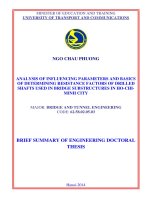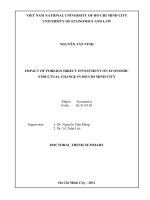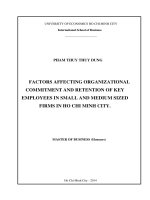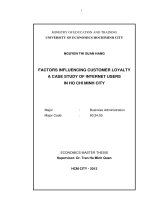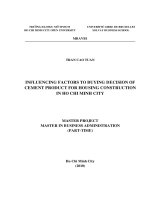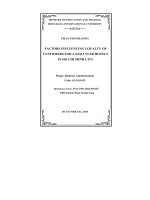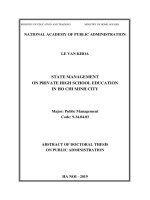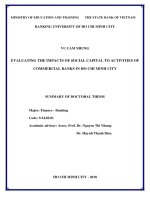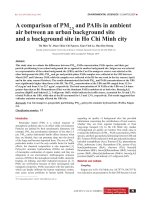Summary of Doctoral thesis: Factors influencing loyalty of customers for 4 and 5 star hotels in Ho Chi Minh city
Bạn đang xem bản rút gọn của tài liệu. Xem và tải ngay bản đầy đủ của tài liệu tại đây (1.04 MB, 20 trang )
MINISTRY OF EDUCATION AND TRAINING
HONG BANG INTERNATIONAL UNIVERSITY
---------PHAN THANH LONG
FACTORS INFLUENCING LOYALTY OF
CUSTOMERS FOR 4 AND 5 STAR HOTELS
IN HO CHI MINH CITY
Major: Business Administration
Code: 62.34.01.02
Instructor:Assoc. Prof. PhD. Đinh Phi Hổ
PhD Student Phan Thanh Long
Ho Chi Minh City, 2018
The work was completed at:
Hong Bang International University
Instructor:
Assoc. Prof. PhD. Đinh Phi Hổ
Review 1: Assoc. Prof. PhD. Nguyen Quyet Thang
Review 2: Assoc. Prof. PhD. Le Tan Buu
Review 3: Assoc. Prof. PhD. Doan Thi My Hanh
The dissertation will be protected by the thesis review panel at
Hong Bang International University
at 09:00 on December 28, 2018
Can find thesis at:
- The Library of Hong Bang International University
215 Dien Bien Phu Street, Ward 15, Binh Thanh District, Ho
Chi Minh City.
- General Sciences Library of Ho Chi Minh City
69 Ly Tu Trong Street, Ben Thanh Ward, HCMC.
- National Library of Vietnam
31 Trang Thi Street, Hoan Kiem District, Hanoi
LIST OF RESEARCH WORKS
1. Phan Thanh Long (2018), Effects of service quality on
customer satisfaction and customer loyalty: A case of four and
five star hotels in Ho Chi Minh City, Vietnam, and Business
Horizons (Scopus).
2. Phan Thanh Long (2018), Factors influencing loyalty of
customers for 4 and 5 star hotels in HCMC, Journal of
Economics and Forecasting.
3. Phan Thanh Long (2018), The Impact of Service Quality on
Satisfaction and Loyalty of Customers Using 4 and 5-star
Hotels in Ho Chi Minh City, Scientific Workshop (ISBN : 973604-73-5980-6).
1.
CHAPTER 1
OVERVIEW OF RESEARCH PROJECT
1.1. BACKGROUND TO RESEARCHRESEARCH BACKGROUND
After joining WTO, the government has determined that tourism is the key economic sector that
needs to be invested in proportion. Reality shows that Vietnam hasa lot of advantages in terms of
tourism potential (many beautiful natural landscapes, long coastline along the country, variety of
national parks are preserved and developed, etc.), besides, Vietnam is also a country with
political economy which are currently being considered significantly stable by the international
community. It is now easily seen thatVietnam has become a focal point for attracting many
domestic and foreign tourists.
In recent years, more and moreVietnamese tourists tend to return back to domestic tourism, the
population of Vietnam is about 90 million people, together with improved living standards, this is
a source of abundant tourists in the tourism industry. Particularly for international visitors, there
have been recently positive changes from the general department to attract the return of visitors.
However, the international and domestic tourism market in the short and medium term has not
tended to be clear, the structure of hotel guests and resort guests is constantly changing.
Vietnamese travelers, as well as international visitors, have also changed somewhat from
previous years. They are more demanding, more interested in values and service, and more
informed about the trends nowadays. As a result, what do hotel managers do to solve this
problem? There are many options to answer this question, but now most hotel managers do not
understand what visitors need and want? As the needs of the visitors have risen to modern living
lifestyle? Therefore, how do visitors continue to use the service at the hotel, managers need to
find out the factors that affect the loyalty of the visitors, in other words, to find out the customers’
need? That is the most important thing for hotel managers. The creation of loyalty will bring
many benefits for tourism units in general and business units in particular.
1.2. OBJECTIVES AND STUDY QUESTIONS
The research objectives are: (i) determine factors influencing the loyalty of customers using 4
and 5-star hotel service in Ho Chi Minh City in a multidimensional approach in the service
quality model; (ii) assessing the impact of customer loyalty factors on the use of 4 and 5-star
hotels in Ho Chi Minh City based on a multidimensional approach in service quality model; (iii),
propose some policy recommendations to increase the loyalty of customers using 4 and 5-star
hotels in Ho Chi Minh City.
About the research question:
1.3. OBJECT AND SCOPE OF THE STUDY
1.3.1. Research subjects
Research subjects of the project: loyalty of customers using 4 and 5-star hotels in Ho Chi Minh
City.
About the subject of the survey: customers are using the service / products in 4, 5 star hotels in
Ho Chi Minh City.
1.3.2. Research scope of the project
On theoretical grounds:
Firstly, the research focuses on customer loyalty in terms of their evaluation of service quality
and satisfaction.
Secondly, customer loyalty can be approached in a variety of ways: (i) customer behaviors, (ii)
customer attitudes, and (iii)the combination between the two that were mentioned . Within the
scope of the topic, the author approaches customer loyalty from an attitudinal perspective.
Spatial scope: The author conducted the survey in Ho Chi Minh City.
Time Range: Qualitative Research: 5/2015 to 01/2017; Preliminary quantitative study: 3/2017;
Official study: 04/2017 to 7/2017.
1.4. RESEARCH METHODS
Methodology: Based on the cognitive system, the methodology used in this study is a mixed
method by combining qualitative research (through expert interviews, focus group discussion
with participants) and quantitative research (through direct interviews with survey participants) to
conduct modeling and research hypotheses.
Methods and tools for processing information (Method / Tools):
Secondary data collection method: Secondary data collected from VNAT.
Primary data collection method: Expert interviews: The author interviewed 10 experts who are
scientists and managers; Group discussion: the focus group discussions were conducted with 10
respondents; Surveys: The author conducted the survey twice: (i) the first time: interviewed 100
respondents; (ii) the second interview: 400 respondents.
Information Processing Tool: Data is encrypted and cleaned using SPSS 20.0 software.
Analysis tool: Data are used to evaluate the scale using the Reliability Analysis tool through
Cronbach's Alpha, EFA, CFA and SEM.
1.5. NEW THEMES
On the academic side: (i) the topic identifies factors influencing customer loyalty to the 4 and 5star hotel system in HCMC; (ii), the topic of implementing a service-oriented approach to service
quality in a multidimensional approach (direct and indirect combination) to consider the impact
on customer loyalty Service at 4, 5 star hotels in Ho Chi Minh City. The research results of the
project have demonstrated the loyalty of customers directly affected by customer satisfaction and
04 components of service quality (reliability, responsiveness, tangible means and assurance), and
is indirectly affected by the overall service quality and its five components (reliability,
responsiveness, tangible means, empathy and assurance); (iii), the topic of adjusting the scale of
loyalty, satisfaction, quality of service and its components for 4, 5 star hotel in Ho Chi Minh City
to complement the ladder system measure theory.
Practically: (i), the theme is to help 4, 5 star hotel managers, policymakers identify and measure
the factors that influence customer loyalty. , 5 stars in Ho Chi Minh City; (ii), the topic also
suggests some feasible implications for increasing visitor loyalty, enhancing the competitiveness
of tourism destinations.
1.6. STRUCTURE OF THESIS
The research project consists of 5 chapters presented in the following order: Chapter 1: Overview
of research topics; Chapter 2: Theoretical Foundations and Research Models; Chapter 3:
Research Design; Chapter 4: Research Results; and Chapter 5: Conclusions and Implications for
Research.
CHAPTER 2
THEORETICAL BASIS AND RESEARCH MODEL
2.1. THEORY OF THEORY
2.1.1. Loyalty
Customer loyalty refers to the tendency of a customer to buy and use a brand's product or service
in a various choices of brand that is widelymarketed and repeat this behavior (Chaudhuri and
Holbrook , 2001); Expressing attitudes or behaviors attached to the customer's service
provider(Oliver,1993).
Customer loyalty can be approached under several perspectives: customer behavior (Backman
and Crompton, 1991, Chaudhuri and Holbrook, 2001, Yoon and Uysal, 2005, Kabiraj and
Shanmugan, 2011; (Backman and Crompton, 1991; Chaudhuri and Holbrook, 2001; Yoon and
Uysal, 2005; Kabiraj and Shanmugan, 2011; Iordanova, 2016), and the angle of integration
(Backman and Crompton , Yoon and Uysal, 2005; Iordanova,2016).
Access to Customer Behavior: This approach considers customer loyalty through repetitive
purchases, using a product / service frequently (Chaudhuri and Holbrook, 2001; Kabiraj and
Shanmugan, 2011). In this approach, loyalty is a commitment of the customer to purchase or use
the brand of a product / service in the future, although influenced by market situations and
impacts can do. Abnormal customer behavior change (Oliver,1997).
Reach from the perspective of the customer: This approach of loyalty is based on the attitudes of
customers who want to emphasize the consumer's intention to consume the product / service
(Kabiraj and Shanmugan, 2011). Thus, customer loyalty according to this view is expressed by
their sympathetic attitude to the product / service and will use that product / service over time
(Rossiter and Percy, 1987). The Indicate the intention to purchase the product / service as a
primary choice (Oliver, 1997).
Integrated approach: This approach examines customer loyalty based on a combination of
customer attitudes and behaviors (Backman and Crompton, 1991, Yoon and Uysal, 2005,
Iordanova, 2016. ). According to this approach, customers who buy and are loyal to a particular
brand must have a positive attitude toward the brand (Yoon and Uysal, 2005).
2.1.2. Service quality
Concept:
Quality of service is seen as the distance between customer expectations and their perceptions
when using service (Parasuraman et al., 1985), as is the ability of a service to include Reliability,
accuracy, ease of use, ease of repair, and other valuable attributes to perform its function (Kotler
et al., 2005).
Quality of service model
Model of Gronroos (1984): By Gronroos (1984), quality of service is measured by three
components: technical quality, functional quality and image quality.
Model of Parasuraman et al. (1985, 1988, 1991, 1994): Parasuraman et al. (1985, 1988) suggest
that service quality is measured by five components by SERVQUAL: reliability, responsiveness,
assurance, tangible means and empathy. Parasuraman et al. (1991) assert that SERVQUAL is a
complete scale of service quality, value and reliability, and can be applied to all types of service;
In addition, the results of the study by Parasuraman et al. (1991) also showed that the quality of
service, including 05 components and 05 components, had the same effect on quality of service.
In 1994, Parasuraman et al. (1994) argued that service quality was one of the three components
that impacted customer satisfaction along with product quality and price.
Model of Dabholkar et al. (2000): Dabholkar et al. (2000) suggest that service quality is directly
influenced by four factors: reliability, personal attention, benefits, characteristics of products /
services; and quality of service will have an impact on customer satisfaction and hence influence
the intended use of the product.
2.2. OVERVIEW OF RELATED STUDIES
Empirical studies of customer loyalty to the quality of service of local and foreign scientists are
based mainly on the model of Parasuarman et al. (1985, 1988), consisting of five components :
reliability, tangible means, empathy, responsiveness and service (Lawrence and Lucy, 2016;
Nguyen Hue Minh et al., 2015; Mai Ngoc Khuong et al., 2015; Nguyen ThiBich Dao and
Nguyen Huu Tin, 2015; NhamPhong Tuan and Nguyen Thi Hai Linh, 2014; Hoang Sa Dang and
Ying Fang Huang, 2014; Galib, 2013; Kofi et al., 2013; Xiangyu and Jarinto, 2012; Rousan et al.,
2010. ). However, major studies conducted in developed countries differ in their level of
economic and cultural development over Vietnam (Lawrence and Lucy, 2016; Galib, 2013; Kofi
et al. , Xiangyu and Jarinto, 2012; Rousan et al., 2010) or in Da Nang, Hanoi, KienGiang
(Nguyen Hue Minh et al., 2015; NhamPhong Tuan and Nguyen Thi Hai Linh, 2014; Hoang Sa
Dang and Ying Fang Huang, 2014) or the previous time in Ho Chi Minh City (Mai Ngoc Khuong
et al., 2015) also differs from the 4 and 5 star hotels in Ho Chi Minh City. the present time when
the ASEAN Council took effect. In addition, most studies of the impact of service quality on
customer loyalty or customer satisfaction are ongoing research, which means that these
components represent quality of service. and when researching service quality affects satisfaction
or loyalty, these components influence satisfaction or loyalty (Lawrence and Lucy, 2016; Nguyen
Hue Minh et al., 2015; Mai Ngoc Khuong et al., 2015; Nguyen ThiBich Dao and Nguyen Huu
Tin, 2015; NhamPhong Tuan and Nguyen Thi Hai Linh, 2014; Hoang Sa Dang and Ying Fang
Huang, 2014; Galib, 2013; Kofi et al. Xiangyu and Jarinto, 2012; Rousan et al., 2010); or indirect
research ie study the components that affect service quality and service quality as a factor
(measured by specific five-dimensional observational variables in addition to the components of
service quality ) have an impact on service quality and satisfaction (Lee et al., 2000; Tsou and
Liao, 2010). While the interaction effect between service quality components and overall service
quality (Parasuraman et al., 1991).
Therefore, an empirical study on the quality of 4 and 5 star hotels in Ho Chi Minh City is needed
to examine the relationship between these components and the overall service quality. Examines
the impact relationship between service quality and its components with customer satisfaction
and loyalty.
2.3. MODELS AND PROBLEMS FOR RESEARCH PROPOSAL
In this study, the authors used the model of Parasuraman et al. (1985, 1988) to measure the
quality of 4, 5 star hotel services through the SERVQUAL scale because SERVQUAL is a
complete scale of Quality of service, value and reliability (Parasuraman et al., 1991).
Quality of service and its components
Service quality is viewed as the distance between customer expectations and their perceptions
when using service (Parasuraman et al., 1988); The extent to which the service responds to
customer expectations (Lewis & Mitchell, 1990). As such, the quality of hotel services is
reflected in the subjective perception of customers about the quality of services provided by the
4, 5 star hotel system compared with their expectations. At the same time, Parasuraman&
Associates (1988) has released five components of quality of service including:
Reliability: is considered through the ability of the supplier to respond accurately and reliably to
the services they provide to clients (Parasuraman et al., 1988). Thus, the reliability of customers
for the quality of 4 and 5 star hotels is reflected in the fact that the hotel system of 4, 5 stars
always perform what they promise to customers, always support Customer service is always
stable and reliable, always notify customers when the service will be done.
Tangible means: assessed through facilities, equipment and staff (Parasuraman et al., 1988).
Thus, the tangible means of the 4, 5 star hotel system are understood as the facilities, and the
staffs of the hotel are available to meet the expectations of customers as the facilities are packed.
Great, professional and beautiful staff.
Response: assessed through the ability to meet customer needs and provide services quickly
(Parasuraman et al., 1988). Thus, the response of the hotel system 4, 5 stars in the city of Ho Chi
Minh City is reflected by the hotel always support customers when they require a quick and
timely, always support customers when they order.
Assurance: assessed through employee knowledge and courtesy as well as their ability to create
customer confidence (Parasuraman et al., 1988). As such, the assurance of the hotel expresses the
ability of the staff of the hotel through communication and behavior of employees to customers
who have been using the hotel services by answering the Inquiries of customers polite, courteous
should give them peace of mind.
Empathy: assessed through care, customer service (Parasuraman et al., 1988). Thus, the
sympathy of the hotel expressed through the attention, customer care of hotel staff to customers
who have been using the company's services, always understand what the customer. center.
Loyalty
Customer loyalty refers to the tendency of a customer to buy and use a brand's product or service
in a set of competing brands available on the market and repeat this behavior (Chaudhuri &
Holbrook , 2001). Zeithaml& Associates (1996) argue that consumers value the service of a good
company and they tend to promote that company, and more importantly, express their preference
for the company. They are more likely to buy, buy more, and accept higher prices without
moving to other services of the same type that are available on the market, in other words,
quality. Service is considered as the factor to create customer loyalty. As such, customer loyalty
to hotel services is reflected in the attitude and behavior of customers in the continued use of the
hotel services.
Quality of service is considered by many researchers as the determining factor for customer
loyalty Monal& Girish (2012). The results of Tefera and Govender (2016), Mai Ngoc Khuong et
al. (2015), Galib (2013, Kofi et al. (2013), Xiangyu and Jarinto (2012), Rousan et al. (2010)
Quality of service is a factor that influences customer loyalty when they use hotel services. In
addition, customer satisfaction and loyalty are closely related to customer loyalty. The results of
Kasiri et al. (2017), Wu (2016), Tefera and Govender (2016), Mai Ngoc Khuong et al. (2015),
Orela and Karab (2014) , Xiangyu and Jarinto (2012) point out that when customers are satisfied
with their travel services, the hotels they use will make them loyal to the service providers. , the
author hypothesized H1: Reliability Affecting loyalty (+) H2: Visible means affecting loyalty (+)
H3: Responsiveness influencing loyalty (+) H4: affect loyalty (+); H5: Empathy affects loyalty
(+); Q6: Overall service quality affects loyalty (+); Q7: Satisfaction influences loyalty (+).
Satisfaction
Customer satisfaction is considered the most emotional state with the product / service used
(Spreng et al., 1996); as customer response to satisfying expectations (Oliver, 1997); to the extent
that their needs are met (Castaneda et al., 2009).
Quality of service and satisfaction are two different but closely related concepts in service
research (Parasuraman et al., 1988). Quality of service is considered the cause of customer
satisfaction (Cronin & Taylor, 1992; Parasuraman et al., 1994; Spreng&Mackoy, 1996;
Dabholkar et al., 2000). In addition, the research results of Xiangyu and Jarinto (2012), Hoang Sa
Dang and Ying-Fang Huang (2014), NhamPhong Tuan & Nguyen Thi Hai Linh (2014), Nguyen
ThiBich Dao and Nguyen Hieu Tin 2015), Nguyen Hue Minh et al. (2015), Tefera &Govender
(2016), Lawrence and Lucy (2016), Ismail et al. (2016), Kasiri et al. (2017) in the field of hotel
and tourism The quality of service is the factor that affects the satisfaction of customers. Thus,
the author hypothesizes H8: Reliability has an impact on customer satisfaction (+); H9: Tangible
means affecting customer satisfaction (+); Q10: Responsiveness has an impact on customer
satisfaction (+); H11: assurance of impact on customer satisfaction (+); H12: Empathy Affects
Customer Satisfaction (+); Q13: Overall service quality has an impact on customer satisfaction
(+).
In addition, the results of Parasuraman et al. (1991), Nguyen Van Si and Nguyen Viet Bang
(2017) show that overall service quality is affected by five components: reliability, tangible
means , responsiveness, assurance, and empathy. Thus, the hypothesis H14: The reliability has
the same effect on the quality of service (+); H15: tangible means have the same impact on
quality of service (+); H16: The response has the same effect as the quality of service (+); H17:
Assurances have the same impact on quality of service (+); H18: Empathy has the same impact
on quality of service (+).
Figure 2.5. Model and hypotheses of the author
(Source: author's build)
CHAPTER 3:
RESEARCH DESIGN
3.1 RESEARCH PROCESS
This study combines qualitative research and quantitative research. Qualitative interviews were
conducted through expert interviews and focus group discussions. Next, the author conducted a
preliminary quantitative study by interviewing 100 respondents to adjust the scale. The formal
study was conducted by interviewing 350 respondents to test the model and hypothesis.
3.2. QUALITATIVE RESEARCH
3.2.1. Qualitative research design
Talk about the same pair of experts
Interview method: The interviews were conducted in the form of an exchange between the author
and the experts on the topic: factors affecting the loyalty of customers using the services at the
hotel 4. , 5 stars in the area of HCMC. The entire interview process is recorded on paper.
Data Analysis: Collected data are used to identify factors affecting loyalty; Adjust the observable
variables to measure research concepts.
For group discussion
Interview method: Group discussions were conducted in the form of seminars on the topic:
factors affecting the loyalty of customers using services at 4, 5 star hotels. in HCMC. The entire
discussion process is documented on paper.
Data Analysis: Collected data are intended to redefine the factors that affect loyalty; Adjust the
observable variables to measure research concepts
3.2.2. Results of qualitative research
3.2.2.1. Discussion results with experts
The results show that: (i) customer loyalty to the 4 and 5-star hotel chain in HCMC is affected by
satisfaction, quality of service and its components; (ii) thirty four observation variables used to
measure loyalty, satisfaction, quality of service and its components were formed
3.2.2.2. Group discussion results with consumers
The results show that: (i) customer loyalty to the 4 and 5-star hotel chain in Ho Chi Minh City is
also influenced by satisfaction, quality of service and its components; (ii) thirty four observation
variables used to measure the concept of loyalty, satisfaction, quality of service and its
components have been established. Specifically:
Loyalty scale: including 04 variables of observation: LO1: I always think of hotel services
whenever needed, LO2: I will not use other hotel services if the hotel is willing to provide, LO3 :
I will use back the hotel services, LO4: I will world hotel service to other users
Satisfaction scale: SAT1: I am pleased to use the services at the hotel, SAT2: I am satisfied with
the management and quality of service of the hotel, SAT3: I comedy Satisfying the hospitality
and work of hotel staff, SAT4: I am satisfied with the management process and check in and
check out procedures of the hotel.
Service quality scale: including 04 observation variables: OQS1: Quality of service provided by
the hotel is higher than that of other hotels, OQS2: Quality of service provided by hotel OQS3:
The quality of service provided by the hotel is of high standard, OQS4: Overall, the quality of the
service meets the expectations of my quality of service. .
Scale of tangible means: including 04 observation variables: TAN1: The hotel has modern
equipment, TAN2: The hotel has spacious facilities, creating trust for customers, TAN3: Hotel
staff
have
TAN4:
The
facilities
of
the
hotel
meet
the
needs
of
the
hotel.
Reliability: including 05 observations: REL1: The hotel promised to do something specific (like
setting up customer service, after-sales service) then that would be done, REL2: When customers
are in trouble, the hotel will always be solving problems timely, REL3: The hotel services are
stable and reliable, REL4: The hotel provides the service at the right time, REL5: The hotel
always informs customers when the service will be performed.
Response Level: includes 04 variables: RES1: Hotel staff always promptly respond to customer
requests for service changes such as change of billing information, internet service, RES2: Hotel
staff are always present when customers have trouble, RES3: Hotel staff never too busy to meet
customer requirements, RES4: Business / customer Always receive service support from the
hotel staff.
Scope of Assurance: including 04 observation variables: ASS1: Communication style, behavior
of hotel staffs increasingly create trust for customers, ASS2: Business / customer feel secure
When using hotel services, ASS3: Hotel staff are always courteous and courteous to customers,
ASS4: Hotel staff have enough knowledge, expertise to answer as well as customer support.
Empirical Measurement:Including 05 observation variables: EMP1: Hotel staffs show interest
to each customer, EMP2: Hotel staff are always interested in customers, EMP3: Hotel staff
understands the special needs of guests. EMP4: Hotel staff pay attention to the issues that
customers most interested, EMP5: Hotel staff always have the convenient time to serve the needs
of customers
3.3. PRINCIPAL QUESTIONNAIRE
Preliminary qualitative research was conducted by direct interview with 100 respondents who
were surveyed by convenient sampling method to screen and determine the scale structure.
Results showed that all 34 observational variables used to measure the eight study concepts met
the criteria for Cronbach's Alpha coefficient analysis and EFA discovery factor analysis.
3.3. RESEARCH
About sampling and sampling methods: The author conducted a direct interview of 350
respondents
(322
valid
responses)
using
a
convenient
sampling
method.
On Data Processing Techniques: Data collected were analyzed by means of reliability analysis,
EFA analysis, CFA analysis and SEM linear modeling.
CHAPTER 4
RESEARCH RESULTS
4.1. RESEARCH SAMPLES
The author conducted a survey of 350 respondents (of which 322 answered correctly). Of the 322
valid responses, 187 respondents used the service at 28 five-star hotels (accounting for 58.1%)
and 135 clients using the service at 47 four-star hotels in Ho Chi Minh City. Accounting for
41.9%; 197 male customers (61.2%), 125 females (28.8%); 85 customers have Vietnamese
nationality (26.4%), 273 foreigners (73.6%).
4.2. RESULTS OF RELIABILITY
The results show that all scales meet the requirements for reliability analysis through the
Cronbach's Alpha coefficient. Specifically: Cronbach's Alpha coefficient of the LO scale is
0.871; SAT is 0.846; OQL is 0.868; REL is 0.866; RES is 0.840; ASS is 0.838; EMP is 0.833;
and TAN is 0.802.
4.3. RESULTS OF DISCUSSION ANALYSIS
About EFA results for service quality components
The EFA results show that 22 variable observations measuring service quality components after
EFA analysis were cited for five elements corresponding to 05 concepts with a total deviation of
65.16% at Eigenvalue of 2.548.
About EFA Quality of service Results
The EFA results show that: 4 variable observations measure the concept of service quality after
EFA analysis, which is cited as one factor with a total variance of 71.705% at the Eigenvalue of
2.868.
About EFA Customer satisfaction Results
The EFA results show that four observed variables after EFA analysis were extracted with one
factor corresponding to one concept with a total deviation of 68.650% at the Eigenvalue of 2.746.
About EFA Loyalty Results
The EFA results show that 4 observed variables after EFA analysis were extracted with one
factor corresponding to one concept with a total deviation of 72.139% at the Eigenvalue of 2.886
4.4. RESULT OF ANALYSING DECIDING FACTORS
All 34 observational variables used to measure the study concepts met the conditions in the CFA
analysis.
4.5. RESULTS OF MODELING AND RESEARCH IMPLICATIONS
Results of test model study: The results show that the model has Chi2 value = 684,754, df = 509;
Cmin / df = 1,345 with p-value = 0.000 (<0.05) was not satisfactory as expected due to sample
size. However, other indicators show that this model is consistent with the data collected from the
market: TLI = 0.962; CFI = 0.966; RMSEA = 0.033.
Figure 4.10. Results of the model test
(Survey Results, 2017)
Note: Coefficients of measure: χ2 / d.f. TLI> 0.90 (Hair et al., 2006), CFI> 0.95 (Hu &Bentler, 1999), RMSEA <0.08 (Hair et al., 2006 ,
2006), p - value> 0.05 (Hair et al., 2006).
About the results of testing hypotheses
Hypothesis testing results are accepted. Results of hypothesis testing are presented in Table 4.15.
Table 4.15. Test results hypothesis research
OQL
OQL
OQL
OQL
OQL
<<<<<-
REL
TAN
ASS
RES
EMP
Estimate S.E.
0,313 0,060
0,235 0,056
0,259 0,058
0,277 0,062
0,162 0,056
P
***
***
***
***
0,004
Accepts H14
AcceptsH15
AcceptsH17
AcceptsH16
AcceptsH18
SAT
SAT
SAT
SAT
SAT
SAT
LO
LO
LO
LO
LO
LO
LO
<<<<<<<<<<<<<-
OQL
EMP
REL
TAN
ASS
RES
OQL
SAT
REL
TAN
ASS
RES
EMP
0,290
0,208
0,327
0,206
0,240
0,236
0,021
0,433
0,150
0,167
0,153
0,192
0,079
0,077
0,056
0,062
0,055
0,058
0,062
0,065
0,084
0,057
0,049
0,052
0,055
0,048
***
***
***
***
***
***
0,750
***
0,008
***
0,003
***
0,103
AcceptsH13
AcceptsH12
AcceptsH8
AcceptsH9
AcceptsH11
AcceptsH10
RejectionH6
AcceptH7
AcceptH1
AcceptH2
AcceptH4
AcceptH3
RejectionH5
(Survey Results, 2017)
4.6. DISCUSSION RESULTS
Research results show that:
Firstly, customer loyalty is impacted by four components of service quality (reliability,
responsiveness, tangible and secure means) and customer satisfaction with a 5% , 95%
confidence as following:
LO = 0,433 * SAT + 0,15 * REL + 0,167 * TAN + 0,153 * ASS + 0,192 * RES
This means that customers will be loyal to the 4 and 5 star hotels in Ho Chi Minh City when they
are satisfied with the quality of service they trust, appreciate the ability to meet and evaluate
Highly visible means, and highly responsive.
Secondly, customer satisfaction is directly affected by the quality of service and its five
components (reliability, responsiveness, tangible, empathetic and assurance) of 5% , 95%
confidence.
So:
SAT = 0.290 * OQL + 0.208 * EMP + 0.327 * REL + 0.206 * TAN + 0.240 * ASS + 0.236 *
RES
This means: customers will be satisfied when they appreciate the quality of service of 4, 5-star
hotel.
CHAPTER 5
CONCLUSION AND IMPLICATION
5.1. CONCLUSION
The purpose of this research is to explore factors affecting the loyalty of customers using services
in the system of 4, 5 star hotel in Ho Chi Minh City; Measure the impact of these factors on
customer loyalty; Suggest policies to increase customer loyalty. Based on the theory of loyalty
and scales from the study of Parasuraman et al. (1985, 1988), Mohammad (2012), Dabholka et al.
(2000), Zhilin et al. (2004) ), Tsou and Liao (2010), research models and scales have been
formed. In addition, the author has developed 18 hypotheses, in which: 07 research hypotheses
express the impact of satisfaction, quality of service and its components to loyalty (hypothesis H1
to H7 hypothesis, six hypotheses demonstrate the impact of service quality and its components on
satisfaction (hypothesis H8 to H13 hypothesis), and five hypotheses Impact of service quality
components on service quality (hypothesis H14 to H18).
Research methods used for modeling and research hypotheses are mixed methods (Quantitative
Qualitative Methods).
The test results show that the research model is consistent with data collected from the market;
Results of test hypothesis studies show that: (i) consumer loyalty is influenced by satisfaction and
components of service quality, (ii) satisfaction is influenced by substance service level and its
components, (iii) service quality is affected by its 05 components.
However, the topic also has some limitations: firstly, the topic is only research conducted in 4, 5
star hotels in Ho Chi Minh City; Secondly, the subject of the survey was only 322 respondents
who were surveyed and could not represent the study population. Finally, the topic is just to test
the relationship between research concepts but not to analyze the behavior of different groups in
these relationships.
5.2. IMPLICATIONS FOR RESEARCH
The hotel industry is a unique service business, whereby the hospitality, commitment and
understanding of customer needs, from the basic needs of the selection of services to the resort.
personal preferences ... will directly affect customer satisfaction and loyalty to the hotel. Through
the practice, the hotel has specific measures to increase the quality of service.
5.3. RESTRICTIONS OF THESIS
Research topics have certain limitations: (i) the topic focuses only on the consumer loyalty to the
hotel system 4, 5-star in Ho Chi Minh City. Therefore, this study should be extended to other
cities such as Hanoi, Da Nang, Can Tho, etc .; (ii) the topic of customer loyalty research in terms
of their evaluation of service quality and satisfaction; (iii) the subject only approached loyalty in
terms of attitudes, which means only considering the intentions of clients but not considering
measures in terms of behavior or angle of association; (iv) Due to the limited time and budget of
the study, the author only interviewed 350 respondents (322 valid responses) who use the service
at the system, 4, 5-star hotel in Ho Chi Minh City is so not enough to be representative for the
research crowds; (v) the topic is limited to verifying the relationship between research concepts
but not yet analyzing the behavior of different target groups in these relationships.
